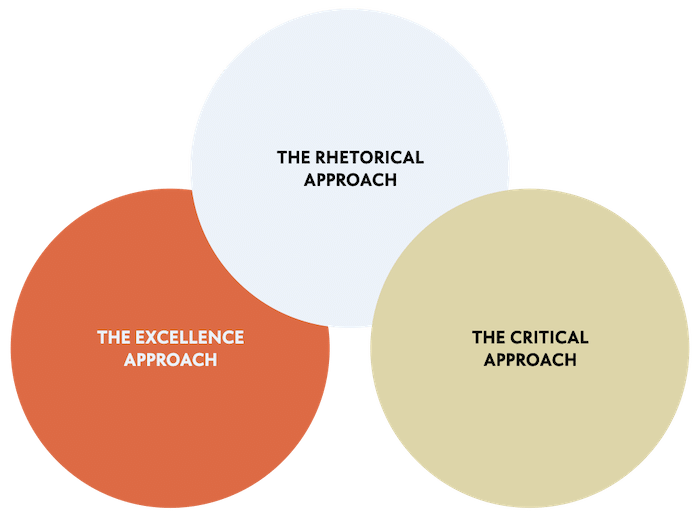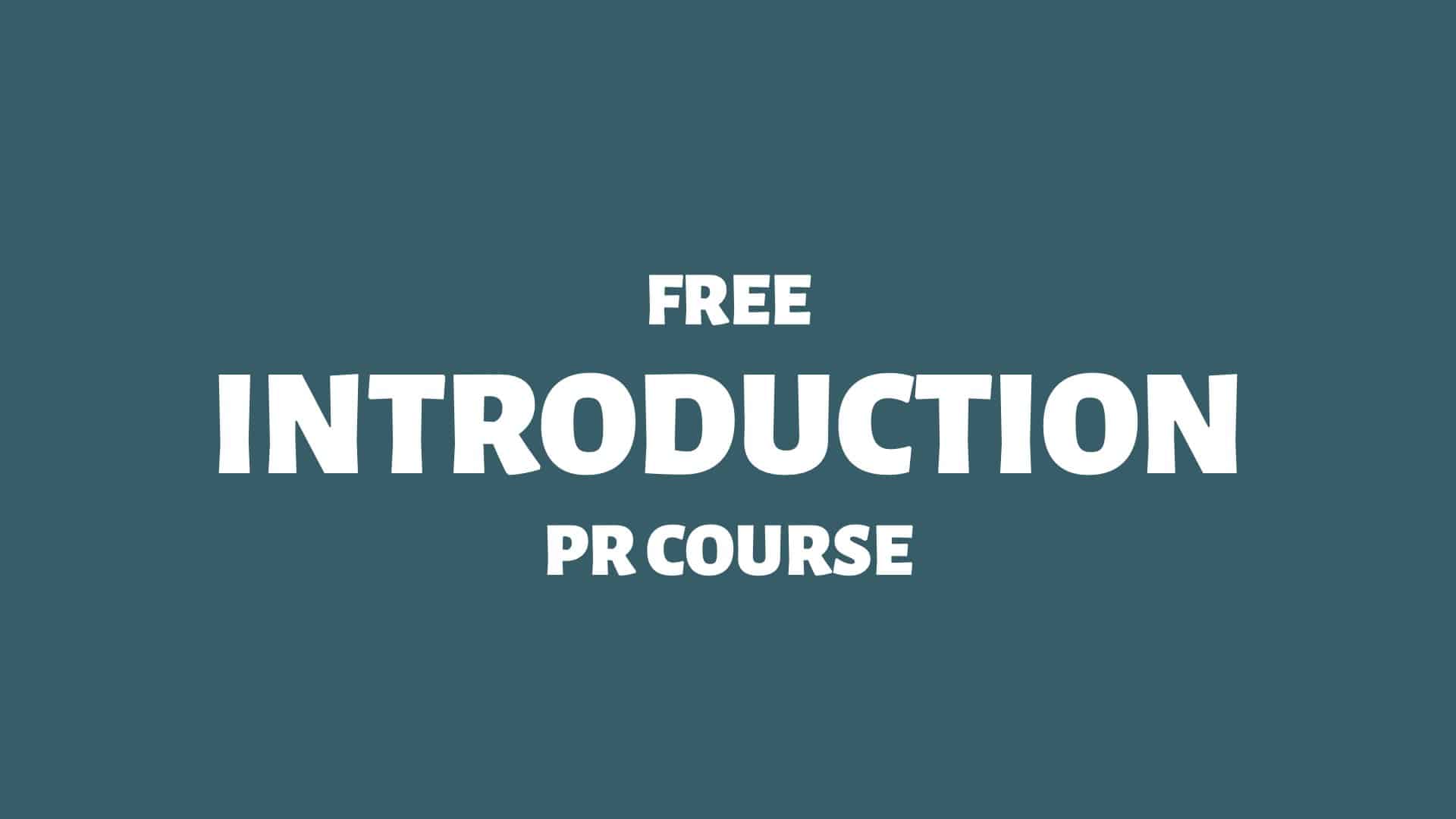There are three fundamental PR approaches:
In this blog post, I’ll explain these three PR approaches and discuss why I prefer the rhetorical approach over the excellence and critical PR approaches.
Here we go:
Approaches To Public Relations
There are three scholarly approaches to public relations (PR):

The excellence PR approach = this public relations approach focuses on objectives and corporate value creation. The underlying motivation behind the theory was that public relations were mainly a variety of tactical tools that desperately needed a management theory to work well in a sophisticated organisation. 1Silfwer, J. (2022, November 6). PR Approaches: Excellence, Rhetorical, and Critical. Doctor Spin | The PR Blog. https://doctorspin.net/pr-approaches/
Notable mentions: James E. Grunig, Larissa A. Grunig
The rhetorical PR approach = this public relations approach stems from ideas dating back to ancient Greece. It’s a psychological theory of how communication structures human culture by shaping human minds. The rhetorical approach is practical and lacks moral judgment. 2Silfwer, J. (2022, November 6). PR Approaches: Excellence, Rhetorical, and Critical. Doctor Spin | The PR Blog. https://doctorspin.net/pr-approaches/
Notable mentions: Edward Bernays, The Toronto School of Communication Theory, Robert Heath
The critical PR approach = this public relations approach is deeply rooted in theories of societal power dynamics. Power is seen as a means of exerting dominance, manipulation, and oppression. The critical approach borrows many ideas from the rhetorical approach by placing them in moral frameworks. 3Silfwer, J. (2022, November 6). PR Approaches: Excellence, Rhetorical, and Critical. Doctor Spin | The PR Blog. https://doctorspin.net/pr-approaches/
Notable mentions: Walter Lippmann, Noam Chomsky
The Excellence Approach to PR
Management theory often focuses on operational excellence. The Excellence Study mapped value creation onto strategic communication and found that best practices create value for an organisation. They reduce costs and risks while increasing revenue.
“The programme of research known as the excellence theory began in the 1960s with J. Grunig’s research on publics found among Colombian farmers. Research then followed on the role of public relations in organisational decision-making, the symmetrical model of public relations, public relations measurement, and how the structure and environment of organisations shape public relations behaviour. […] The excellence theory has evolved into a general theory of public relations as a strategic management function, and ongoing research now is adding concepts and tools that public relations professionals who serve in a strategic role can use.”
Source: Excellence Theory in Public Relations: Past, Present, and Future 4Grunig, J.E., & Grunig, L.A. (2008). Excellence Theory in Public Relations: Past, Present, and Future. https://www.semanticscholar.org/paper/ccfadd878d41454375357ce99ec7fcb148e6b48f
How can PR have such best practices? The answers are, non-surprisingly, management-focused: Leadership roles, goal alignments, high levels of strategic competency, high ethical standards, and two-way symmetric communication with corporate stakeholders.
Who typically prefers the excellence approach?
The Rhetorical Approach to PR
In ancient Greek society, public debate and persuasion were considered the best approaches to ensuring peaceful and stable governance. This was the cradle of ideas like democracy and free speech. There was no best practice, only outcomes from multiple voices.
“Rhetorical theory features how the public relations process becomes enriched through the role co-created, shared meaning plays in society as a blend of mind and self. The rhetorical heritage features the potent role of fact (as interpreted information), judgment, and identification as discourse themes enacted in public arenas. Public relations can add value to society by assuring that choices become enlightened, risks are ethically managed, and relationships are mutually developed. Through ethical rhetorical practice that results from the reflective character of organisations, public relations helps society to be more fully functioning.”
Source: Rhetorical Perspective and Public Relations: Meaning Matters 5Heath, R. L., & Frandsen, F. (2008). Rhetorical Perspective and Public Relations: Meaning Matters. VS Verlag Für Sozialwissenschaften EBooks, 349 – 364. … Continue reading
If you hear a PR professional talk passionately and positively about the importance of persuasion and perception management, they are most likely supporters of the rhetorical approach. They’re focused on language and relationships and think of society descriptively.
Many modern rhetorical concepts have stemmed from the Toronto School of Communication Theory and were later refined and further developed by Robert L. Heath.
Who typically prefers the rhetorical approach?
The Critical Approach to PR
“Critical theory” is a broad term encapsulating tools for analysis from various fields. Examples of such devices for analysis are feminism, cultural studies, structuralism, semiotics, and postmodernism. As a broad approach, it offers a wide range of scholarly criticism.
“The dominance of Excellence Theory in public relations theory and research may be eroding as contemporary issues in corporations, including the concern with activist challenges to reputation management and corporate social responsibility, increase in visibility and demand explanation. […] Excellence Theory’s acknowledgement of once-vilified concepts like persuasion and power sets the stage for critical public relations theory and research to emerge as significantly more capable of addressing activist advocacy and concomitant issues. The paper argues that critical theory, buoyed by acceptance of its key concepts, its increasing access to presentation venues and journals sympathetic to once-marginalised, alternative perspectives, is poised to infiltrate the public relations orthodoxy.”
Source: Public Relations Review 6Coombs, W. T., & Holladay, S. J. (2012). Fringe public relations: How activism moves critical pr toward the mainstream. Public Relations Review, 38(5), 880 – 887. … Continue reading
Since critical PR theory borrows from various scholarly traditions, it’s challenging to summarise the critical approach. But there’s often a focus on societal power dynamics and detailed victimology. The critical approach has many touch points with the rhetorical approach, but they tend to end up on opposite sides of the excellence approach:
While the rhetorical approach finds the excellence approach too normative, the critical approach isn’t normative enough.
Who typically prefers the rhetorical approach?
Read also: 3 PR Approaches: Excellence, Rhetorical, and Critical

THANKS FOR READING.
Need PR help? Hire me here.

What should you study next?
Spin Academy | Online PR Courses

Spin’s PR School: Free Introduction PR Course
Get started with this free Introduction PR Course and learn essential public relations skills and concepts for future success in the PR industry.
Introducing Public Relations
Public Relations History
Publics in Public Relations
Comparing Public Relations
Public Relations Resources
Learn more: All Free PR Courses
💡 Subscribe and get a free ebook on how to get better PR.

Annotations
| 1, 2, 3 | Silfwer, J. (2022, November 6). PR Approaches: Excellence, Rhetorical, and Critical. Doctor Spin | The PR Blog. https://doctorspin.net/pr-approaches/ |
|---|---|
| 4 | Grunig, J.E., & Grunig, L.A. (2008). Excellence Theory in Public Relations: Past, Present, and Future. https://www.semanticscholar.org/paper/ccfadd878d41454375357ce99ec7fcb148e6b48f |
| 5 | Heath, R. L., & Frandsen, F. (2008). Rhetorical Perspective and Public Relations: Meaning Matters. VS Verlag Für Sozialwissenschaften EBooks, 349 – 364. https://doi.org/10.1007/978 – 3‑531 – 90918-9_23 |
| 6 | Coombs, W. T., & Holladay, S. J. (2012). Fringe public relations: How activism moves critical pr toward the mainstream. Public Relations Review, 38(5), 880 – 887. https://doi.org/10.1016/j.pubrev.2012.02.008 |


